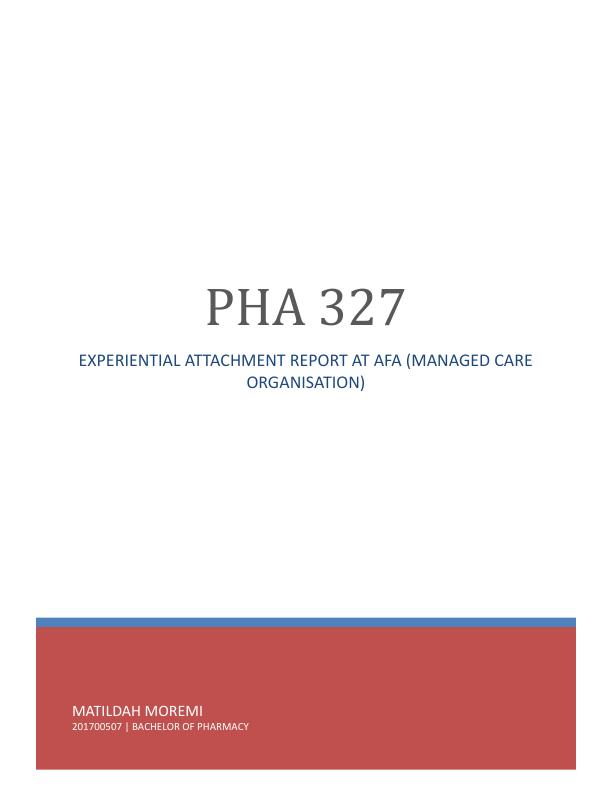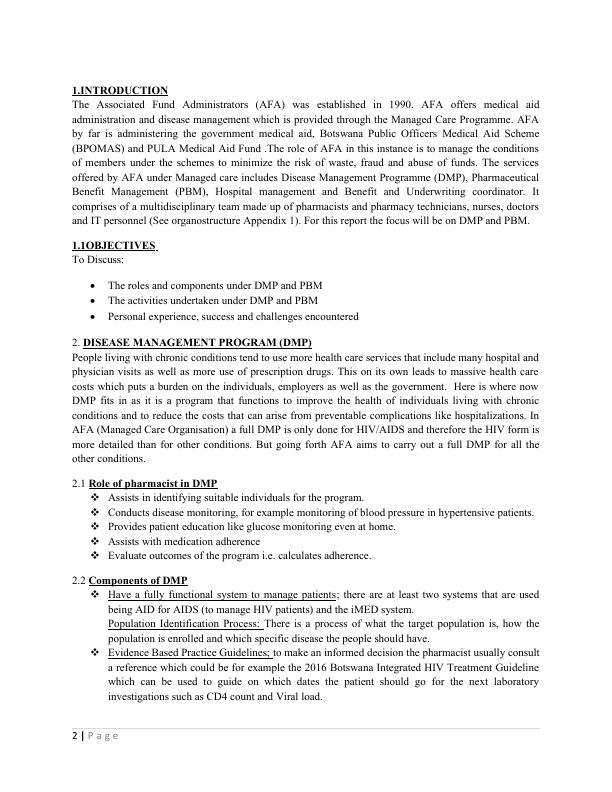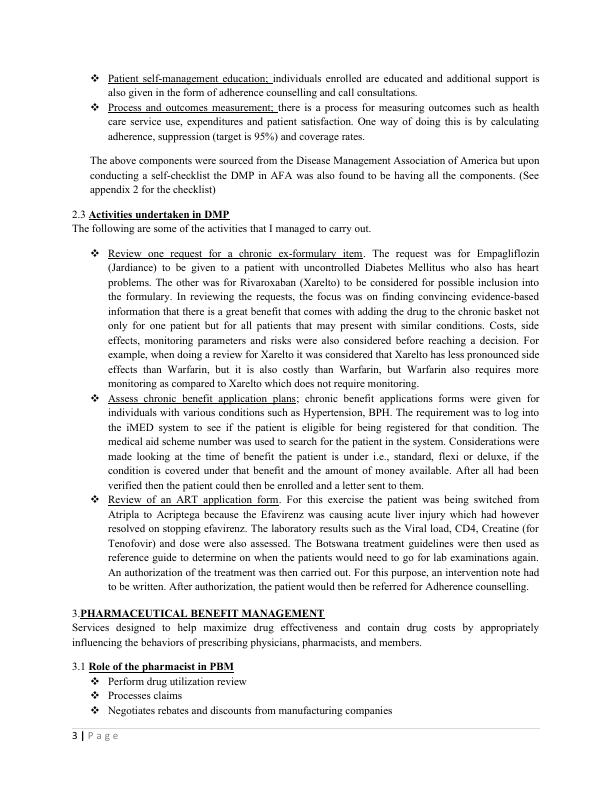Ask a question from expert
disease management program PDF
13 Pages3123 Words215 Views
Added on 2022-01-25
disease management program PDF
Added on 2022-01-25
BookmarkShareRelated Documents
MATILDAH MOREMI
201700507 | BACHELOR OF PHARMACY
PHA 327
EXPERIENTIAL ATTACHMENT REPORT AT AFA (MANAGED CARE
ORGANISATION)
201700507 | BACHELOR OF PHARMACY
PHA 327
EXPERIENTIAL ATTACHMENT REPORT AT AFA (MANAGED CARE
ORGANISATION)

Table of Contents
1.INTRODUCTION..................................................................................................................................2
1.1OBJECTIVES...................................................................................................................................2
2. DISEASE MANAGEMENT PROGRAM (DMP)...............................................................................2
2.1 Role of pharmacist in DMP.............................................................................................................2
2.2 Components of DMP.......................................................................................................................2
2.3 Activities undertaken in DMP........................................................................................................3
3.PHARMACEUTICAL BENEFIT MANAGEMENT..........................................................................3
3.1 Role of the pharmacist in PBM.......................................................................................................3
3.2 Components of PBM........................................................................................................................4
3.3 Activities undertaken in PBM.........................................................................................................4
4. SUCCESSES AND CHALLENGES....................................................................................................4
5. PERSONAL EXPERIENCE................................................................................................................5
REFERENCES..........................................................................................................................................6
APPENDICES...........................................................................................................................................7
Appendix 1 (Managed care organostructure).....................................................................................7
Appendix 2 (Managed care checklist)..................................................................................................8
Appendix 3 (Interview and observation tool)....................................................................................10
1 | P a g e
1.INTRODUCTION..................................................................................................................................2
1.1OBJECTIVES...................................................................................................................................2
2. DISEASE MANAGEMENT PROGRAM (DMP)...............................................................................2
2.1 Role of pharmacist in DMP.............................................................................................................2
2.2 Components of DMP.......................................................................................................................2
2.3 Activities undertaken in DMP........................................................................................................3
3.PHARMACEUTICAL BENEFIT MANAGEMENT..........................................................................3
3.1 Role of the pharmacist in PBM.......................................................................................................3
3.2 Components of PBM........................................................................................................................4
3.3 Activities undertaken in PBM.........................................................................................................4
4. SUCCESSES AND CHALLENGES....................................................................................................4
5. PERSONAL EXPERIENCE................................................................................................................5
REFERENCES..........................................................................................................................................6
APPENDICES...........................................................................................................................................7
Appendix 1 (Managed care organostructure).....................................................................................7
Appendix 2 (Managed care checklist)..................................................................................................8
Appendix 3 (Interview and observation tool)....................................................................................10
1 | P a g e

1.INTRODUCTION
The Associated Fund Administrators (AFA) was established in 1990. AFA offers medical aid
administration and disease management which is provided through the Managed Care Programme. AFA
by far is administering the government medical aid, Botswana Public Officers Medical Aid Scheme
(BPOMAS) and PULA Medical Aid Fund .The role of AFA in this instance is to manage the conditions
of members under the schemes to minimize the risk of waste, fraud and abuse of funds. The services
offered by AFA under Managed care includes Disease Management Programme (DMP), Pharmaceutical
Benefit Management (PBM), Hospital management and Benefit and Underwriting coordinator. It
comprises of a multidisciplinary team made up of pharmacists and pharmacy technicians, nurses, doctors
and IT personnel (See organostructure Appendix 1). For this report the focus will be on DMP and PBM.
1.1OBJECTIVES
To Discuss:
The roles and components under DMP and PBM
The activities undertaken under DMP and PBM
Personal experience, success and challenges encountered
2. DISEASE MANAGEMENT PROGRAM (DMP)
People living with chronic conditions tend to use more health care services that include many hospital and
physician visits as well as more use of prescription drugs. This on its own leads to massive health care
costs which puts a burden on the individuals, employers as well as the government. Here is where now
DMP fits in as it is a program that functions to improve the health of individuals living with chronic
conditions and to reduce the costs that can arise from preventable complications like hospitalizations. In
AFA (Managed Care Organisation) a full DMP is only done for HIV/AIDS and therefore the HIV form is
more detailed than for other conditions. But going forth AFA aims to carry out a full DMP for all the
other conditions.
2.1 Role of pharmacist in DMP
Assists in identifying suitable individuals for the program.
Conducts disease monitoring, for example monitoring of blood pressure in hypertensive patients.
Provides patient education like glucose monitoring even at home.
Assists with medication adherence
Evaluate outcomes of the program i.e. calculates adherence.
2.2 Components of DMP
Have a fully functional system to manage patients; there are at least two systems that are used
being AID for AIDS (to manage HIV patients) and the iMED system.
Population Identification Process: There is a process of what the target population is, how the
population is enrolled and which specific disease the people should have.
Evidence Based Practice Guidelines; to make an informed decision the pharmacist usually consult
a reference which could be for example the 2016 Botswana Integrated HIV Treatment Guideline
which can be used to guide on which dates the patient should go for the next laboratory
investigations such as CD4 count and Viral load.
2 | P a g e
The Associated Fund Administrators (AFA) was established in 1990. AFA offers medical aid
administration and disease management which is provided through the Managed Care Programme. AFA
by far is administering the government medical aid, Botswana Public Officers Medical Aid Scheme
(BPOMAS) and PULA Medical Aid Fund .The role of AFA in this instance is to manage the conditions
of members under the schemes to minimize the risk of waste, fraud and abuse of funds. The services
offered by AFA under Managed care includes Disease Management Programme (DMP), Pharmaceutical
Benefit Management (PBM), Hospital management and Benefit and Underwriting coordinator. It
comprises of a multidisciplinary team made up of pharmacists and pharmacy technicians, nurses, doctors
and IT personnel (See organostructure Appendix 1). For this report the focus will be on DMP and PBM.
1.1OBJECTIVES
To Discuss:
The roles and components under DMP and PBM
The activities undertaken under DMP and PBM
Personal experience, success and challenges encountered
2. DISEASE MANAGEMENT PROGRAM (DMP)
People living with chronic conditions tend to use more health care services that include many hospital and
physician visits as well as more use of prescription drugs. This on its own leads to massive health care
costs which puts a burden on the individuals, employers as well as the government. Here is where now
DMP fits in as it is a program that functions to improve the health of individuals living with chronic
conditions and to reduce the costs that can arise from preventable complications like hospitalizations. In
AFA (Managed Care Organisation) a full DMP is only done for HIV/AIDS and therefore the HIV form is
more detailed than for other conditions. But going forth AFA aims to carry out a full DMP for all the
other conditions.
2.1 Role of pharmacist in DMP
Assists in identifying suitable individuals for the program.
Conducts disease monitoring, for example monitoring of blood pressure in hypertensive patients.
Provides patient education like glucose monitoring even at home.
Assists with medication adherence
Evaluate outcomes of the program i.e. calculates adherence.
2.2 Components of DMP
Have a fully functional system to manage patients; there are at least two systems that are used
being AID for AIDS (to manage HIV patients) and the iMED system.
Population Identification Process: There is a process of what the target population is, how the
population is enrolled and which specific disease the people should have.
Evidence Based Practice Guidelines; to make an informed decision the pharmacist usually consult
a reference which could be for example the 2016 Botswana Integrated HIV Treatment Guideline
which can be used to guide on which dates the patient should go for the next laboratory
investigations such as CD4 count and Viral load.
2 | P a g e

Patient self-management education; individuals enrolled are educated and additional support is
also given in the form of adherence counselling and call consultations.
Process and outcomes measurement; there is a process for measuring outcomes such as health
care service use, expenditures and patient satisfaction. One way of doing this is by calculating
adherence, suppression (target is 95%) and coverage rates.
The above components were sourced from the Disease Management Association of America but upon
conducting a self-checklist the DMP in AFA was also found to be having all the components. (See
appendix 2 for the checklist)
2.3 Activities undertaken in DMP
The following are some of the activities that I managed to carry out.
Review one request for a chronic ex-formulary item. The request was for Empagliflozin
(Jardiance) to be given to a patient with uncontrolled Diabetes Mellitus who also has heart
problems. The other was for Rivaroxaban (Xarelto) to be considered for possible inclusion into
the formulary. In reviewing the requests, the focus was on finding convincing evidence-based
information that there is a great benefit that comes with adding the drug to the chronic basket not
only for one patient but for all patients that may present with similar conditions. Costs, side
effects, monitoring parameters and risks were also considered before reaching a decision. For
example, when doing a review for Xarelto it was considered that Xarelto has less pronounced side
effects than Warfarin, but it is also costly than Warfarin, but Warfarin also requires more
monitoring as compared to Xarelto which does not require monitoring.
Assess chronic benefit application plans; chronic benefit applications forms were given for
individuals with various conditions such as Hypertension, BPH. The requirement was to log into
the iMED system to see if the patient is eligible for being registered for that condition. The
medical aid scheme number was used to search for the patient in the system. Considerations were
made looking at the time of benefit the patient is under i.e., standard, flexi or deluxe, if the
condition is covered under that benefit and the amount of money available. After all had been
verified then the patient could then be enrolled and a letter sent to them.
Review of an ART application form. For this exercise the patient was being switched from
Atripla to Acriptega because the Efavirenz was causing acute liver injury which had however
resolved on stopping efavirenz. The laboratory results such as the Viral load, CD4, Creatine (for
Tenofovir) and dose were also assessed. The Botswana treatment guidelines were then used as
reference guide to determine on when the patients would need to go for lab examinations again.
An authorization of the treatment was then carried out. For this purpose, an intervention note had
to be written. After authorization, the patient would then be referred for Adherence counselling.
3.PHARMACEUTICAL BENEFIT MANAGEMENT
Services designed to help maximize drug effectiveness and contain drug costs by appropriately
influencing the behaviors of prescribing physicians, pharmacists, and members.
3.1 Role of the pharmacist in PBM
Perform drug utilization review
Processes claims
Negotiates rebates and discounts from manufacturing companies
3 | P a g e
also given in the form of adherence counselling and call consultations.
Process and outcomes measurement; there is a process for measuring outcomes such as health
care service use, expenditures and patient satisfaction. One way of doing this is by calculating
adherence, suppression (target is 95%) and coverage rates.
The above components were sourced from the Disease Management Association of America but upon
conducting a self-checklist the DMP in AFA was also found to be having all the components. (See
appendix 2 for the checklist)
2.3 Activities undertaken in DMP
The following are some of the activities that I managed to carry out.
Review one request for a chronic ex-formulary item. The request was for Empagliflozin
(Jardiance) to be given to a patient with uncontrolled Diabetes Mellitus who also has heart
problems. The other was for Rivaroxaban (Xarelto) to be considered for possible inclusion into
the formulary. In reviewing the requests, the focus was on finding convincing evidence-based
information that there is a great benefit that comes with adding the drug to the chronic basket not
only for one patient but for all patients that may present with similar conditions. Costs, side
effects, monitoring parameters and risks were also considered before reaching a decision. For
example, when doing a review for Xarelto it was considered that Xarelto has less pronounced side
effects than Warfarin, but it is also costly than Warfarin, but Warfarin also requires more
monitoring as compared to Xarelto which does not require monitoring.
Assess chronic benefit application plans; chronic benefit applications forms were given for
individuals with various conditions such as Hypertension, BPH. The requirement was to log into
the iMED system to see if the patient is eligible for being registered for that condition. The
medical aid scheme number was used to search for the patient in the system. Considerations were
made looking at the time of benefit the patient is under i.e., standard, flexi or deluxe, if the
condition is covered under that benefit and the amount of money available. After all had been
verified then the patient could then be enrolled and a letter sent to them.
Review of an ART application form. For this exercise the patient was being switched from
Atripla to Acriptega because the Efavirenz was causing acute liver injury which had however
resolved on stopping efavirenz. The laboratory results such as the Viral load, CD4, Creatine (for
Tenofovir) and dose were also assessed. The Botswana treatment guidelines were then used as
reference guide to determine on when the patients would need to go for lab examinations again.
An authorization of the treatment was then carried out. For this purpose, an intervention note had
to be written. After authorization, the patient would then be referred for Adherence counselling.
3.PHARMACEUTICAL BENEFIT MANAGEMENT
Services designed to help maximize drug effectiveness and contain drug costs by appropriately
influencing the behaviors of prescribing physicians, pharmacists, and members.
3.1 Role of the pharmacist in PBM
Perform drug utilization review
Processes claims
Negotiates rebates and discounts from manufacturing companies
3 | P a g e

End of preview
Want to access all the pages? Upload your documents or become a member.
Related Documents
Disease management program PDFlg...
|14
|3501
|258
Better Future Initiative in Pharmaceutical | Analysislg...
|11
|2752
|24
Healthcare System | Assignmentlg...
|10
|2666
|14
Role of Public Health in Health and Social Care - Assignmentlg...
|9
|1426
|404
The Australian Pharmaceutical Benefits Scheme and the consumption of medicines in Australialg...
|11
|2474
|139
Australian Health System Question and Answer 2022lg...
|4
|624
|19